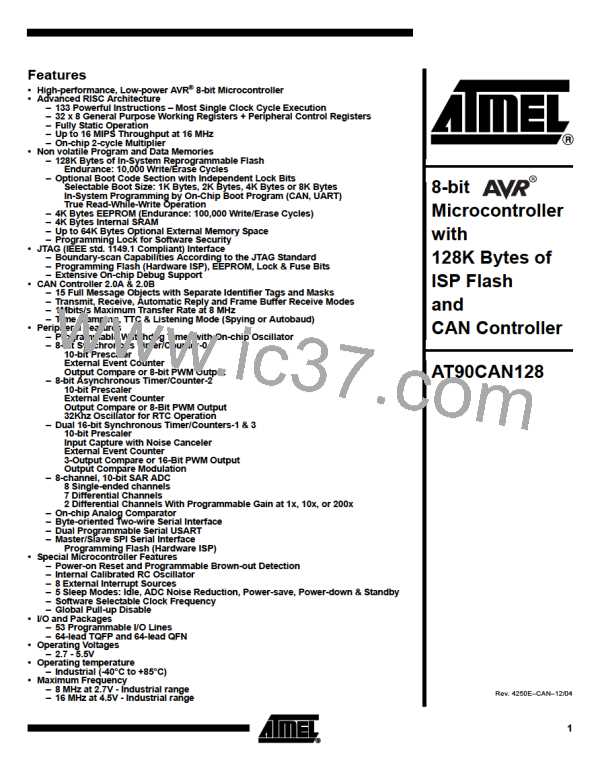AT90CAN128
• AIN1/OC3A – Port E, Bit 3
AIN1 – Analog Comparator Negative input. This pin is directly connected to the negative
input of the Analog Comparator.
OC3A, Output Compare Match A output. The PE3 pin can serve as an External output
for the Timer/Counter3 Output Compare A. The pin has to be configured as an output
(DDE3 set “one”) to serve this function. The OC3A pin is also the output pin for the PWM
mode timer function.
• AIN0/XCK0 – Port E, Bit 2
AIN0 – Analog Comparator Positive input. This pin is directly connected to the positive
input of the Analog Comparator.
XCK0, USART0 External clock. The Data Direction Register (DDE2) controls whether
the clock is output (DDE2 set) or input (DDE2 cleared). The XCK0 pin is active only
when the USART0 operates in Synchronous mode.
• PDO/TXD0 – Port E, Bit 1
PDO, SPI Serial Programming Data Output. During Serial Program Downloading, this
pin is used as data output line for the AT90CAN128.
TXD0, UART0 Transmit pin.
• PDI/RXD0 – Port E, Bit 0
PDI, SPI Serial Programming Data Input. During Serial Program Downloading, this pin
is used as data input line for the AT90CAN128.
RXD0, USART0 Receive Pin. Receive Data (Data input pin for the USART0). When the
USART0 receiver is enabled this pin is configured as an input regardless of the value of
DDRE0. When the USART0 forces this pin to be an input, a logical one in PORTE0 will
turn on the internal pull-up.
Table 42 and Table 43 relates the alternate functions of Port E to the overriding signals
shown in Figure 34 on page 67.
Table 42. Overriding Signals for Alternate Functions PE7..PE4
Signal Name
PUOE
PUOV
DDOE
DDOV
PVOE
PVOV
PTOE
PE7/INT7/ICP3
PE6/INT6/T3
PE5/INT5/OC3C PE4/INT4/OC3B
0
0
0
0
0
0
0
0
0
0
0
0
0
0
0
0
0
0
OC3C ENABLE
OC3C
OC3B ENABLE
OC3B
0
0
0
0
0
0
DIEOE
DIEOV
DI
INT7 ENABLE
INT7 ENABLE
INT6 ENABLE
INT6 ENABLE
INT5 ENABLE
INT5 ENABLE
INT5 INPUT
INT4 ENABLE
INT4 ENABLE
INT4 INPUT
INT7 INPUT
/ICP3 INPUT
INT6 INPUT
/T3 INPUT
AIO
–
–
–
–
79
4250E–CAN–12/04

 ATMEL [ ATMEL ]
ATMEL [ ATMEL ]